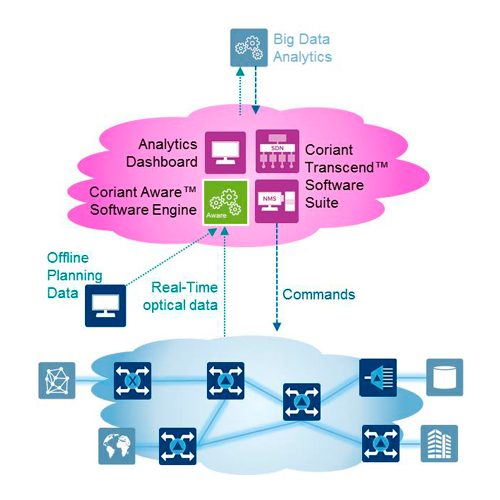As emerging 5G, IoT, and high-speed cloud services drive a new set of dynamic, on-demand connectivity requirements, network operators are exploring the latest advances in software-defined control technologies to maximise the performance of underlying network infrastructure, including deployed fibre assets. In a recent production network field trial, Coriant and Telia Carrier, owner and operator of the world’s number one ranked global network backbone (according to Dyn Research’s global backbone rankings) showcased the operational value of real-time performance awareness and the ability to mine and unlock the revenue potential of residual margin in optical networks.
The industry-first technology trial, conducted on a live fibre route in Telia Carrier’s European backbone network between Hamburg and Prague, included demonstration of operational efficiencies enabled by software-enabled online service planning, in-service optical margin measurement, and real-time health check and impairment analytics. With the ability to leverage real-time visibility and state-of-life responsiveness, this successful field trial represented a fundamental paradigm shift in how optical networks are planned, built, operated and – ultimately – monetised for new revenue opportunities.
During the trial, 200G wavelengths were provisioned on-demand based on the accurate and real-time (DSP-independent) visibility of residual margin and OSNR on the 1,300-kilometre long-haul transmission route. Enabled by sophisticated software algorithms and programmable modulation, the production network field trial featured an industry-first demonstration of in-service optical margin measurement without the need for additional hardware equipment.

Figure 1: Software-driven model for real-time optical performance awareness
Based on Coriant Aware™ Technology and Coriant CloudWave™ Optics, this joint field trial demonstrated important capabilities that are critical to software-driven and automated operations of optical transmission networks that were not possible previously. These capabilities include:
- Assessing real-time, state-of-life optical performance, including linear and non-linear optical impairments, and acting on that information in real-time
- Extending end-of-life by providing a view into future system performance
- Proactively determining where network capacity can be added – and thus monetized – over deployed assets on an on-demand basis
- Improving service availability via dynamic adjustment of transmission capacity and intelligent routing/re-routing of wavelength services
The importance of residual margin in real-time performance awareness
Residual margin represents the most useful measure of received signal quality and determines how much room there is for the signal to degrade without impacting the error-free operation. Residual margin is impacted by OSNR, linear impairments, and nonlinear impairments. Measured in dB, residual margin tells you by how many dB OSNR can be reduced, if linear and non-linear impairments remain constant, until post-Forward Error Correction (post-FEC) errors will occur. Accurately assessing the residual margin requires accurately determining the impact of all three – OSNR alone is not enough! While current coherent receivers are typically able to measure linear effects such as CD, PMD, and PDL, they are not able to measure their impact on signal quality, nor are they able to accurately measure OSNR or the influence of nonlinear penalties.

Figure 2: With state-of-life performance awareness and optimization, operators can turn residual margin into capacity that can be monetised (without additional CapEx) and determine the correct impairment buffer to avoid excessive safety margins
The evolution of the Bandwidth Variable Transponder (BVT) represents an important advance in optical transmission networks that reinforces the critical need for software-driven real-time performance awareness. This class of transponders provides network operators the ability to dynamically tune the optical capacity and transmission reach by adjusting parameters such as gross bit rate, modulation format, FEC coding, and spectral efficiency. In an era of increasingly unpredictable capacity demands and traffic patterns, the ability to assess key performance indicators in real-time and adjust optical network parameters to enhance end-user services marks a significant shift away from the largely static mode of planning, management, and operations that has defined optical networks to date.

Figure 3: Extracting maximum value from investments in Bandwidth Variable Transponders (BVTs)
Coriant Aware™ Technology enables faster and simpler new wavelength planning and provisioning. In addition to reducing the number of steps, boundaries between planning and network management are eliminated. New wavelengths can now be planned and provisioned without needing to draw on skilled planning tool experts. Coriant Aware™ Technology can identify valid options for flexi-rate interface settings and super-channels, including the most optimal options. The technology can also enable wavelength automation with multi-layer ASON/GMPLS or SDN through its open APIs, while reducing OpEx with simplified troubleshooting enabled by accurate real-time visibility of residual margin and OSNR.
As optical networks scale and become more dynamic with the adoption of SDN control and the increased deployment of flexi-rate interfaces with a wider range of modulation schemes and baud rates, the use of software-intelligence to proactively adjust optical capacity in real-time gives operators the tools to maximise the network performance and increase service agility, resiliency, and flexibility – at the lowest total cost of ownership. Validated in a Tier 1 class optical backbone network, these new capabilities unlock the full potential of optical networks through accurate residual margin measurement during real-time operations and state-of-life fibre conditions.
Learn more at www.coriant.com

